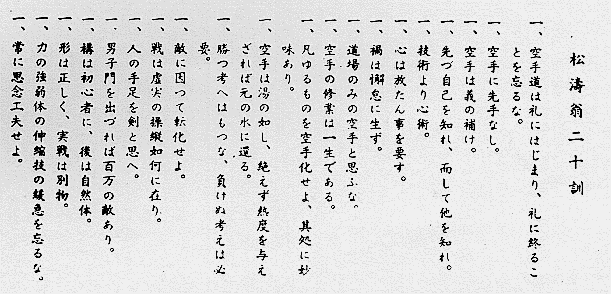Karate is a lifelong pursuit
空手の修業は一生である

This is the ninth in a series of posts to examine Shotokan’s niju kun, Gichin Funakoshi’s list of 20 guiding principles for karate.

The ninth principle is:
空手の修業は一生である
In Romaji:
Karate no shūgyō wa isshō de aru.
In English, I think the best translation is:
Karate is a lifelong pursuit.
Genwa Nakasone’s interpretation of this precept recounts a story from the Hakagure. The gist is that there are four levels of learning:
- The lowest level: Studying, but not really learning.
- The middle level: Recognizing how much you still have to learn.
- The higher level: Being recognized for, and proud of, your achievements.
- The transcendant level: Learning that you will never stop learning.
This precept is Funakoshi’s recognition of that final level, and his hope that students of karate will reach it. Karate takes a lifetime to “master”, and you’ll never know all there is to know.
I think about this every time someone says, “Oh, you know karate?”
Karate isn’t really something you “know”, is it? You can’t “know” karate any more than you can “know” math, or history, or chemistry. There’s always more to learn. The only things you can really “know” are very specific use cases. I “know” how to replace a light switch, and I “know” how to read a map, etc.
We in the karate community are generally very aware of this. For example, I would never say I “know” a kata. Instead I say I can “get through” a kata, or “have a decent grasp” of a kata. With regard to karate in general, I feel comfortable saying I “know the basics”, because that’s what a black belt represents, but I’m still constantly getting better (I hope).
Furthermore, learning karate is a bit of a moving target. Gichin Funakoshi, himself, recognized this and called it out in writing throughout his lifetime.
-
In the 1931 preface to the first edition of Karate-do Kyohan, Funakoshi explained why this book is a necessary revision of his earlier work:
Due to further studies and experiences that have taken place in the last ten years or so, the techniques and names that have been changed are many.
-
And in his 1956 autobiography Katate-do My Way of Life, Gichin Funakoshi wrote:
The karate that high school students practice today is not the same karate that was practiced even are recently as ten years ago, and it is a long way indeed from the karate I learned when I was a child in Okinawa.
But even if karate didn’t change, our bodies do, and we end up needing to change or relearn techniques to accommodate new limitations. When I had a hip replaced, it changed the way I kick, which changed the frequency with which I kick, etc.
Of course, another interpretation of this is that karate can be enjoyed throughout your life, and that’s certainly true. Iain Abernethy talks about this at length in the video below, but I’ll summarize like this:
Karate is something you can do at all stages of life. In your youth you may choose to compete. As you get older, you may choose to teach others. In your older years you may just use karate to be fit, active, and social.
To put that another way, I don’t know many 80 year-olds still playing football every week, or ice hockey, but I know plenty of 80 year-olds still doing karate. Sure, karate in your 80s will look different from karate in your 20s, but it’s still karate.
Beyond physical training, karate also has social and psychological benefits we can enjoy throughout our lives. No matter what’s going on in my life, I know there’s a place I can go and forget about it all for a few hours each week. Likewise, no matter where I go on the planet, I can find a group of like-minded people to spend time with.
To summarize, “karate is a lifelong pursuit” because there’s always more to learn and, as your life changes, your karate can change with it.